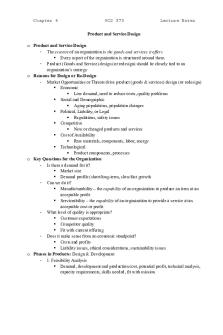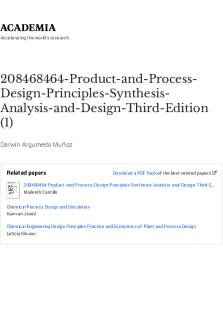Product and Service Design PDF

| Title | Product and Service Design |
|---|---|
| Course | Basic Operations Management |
| Institution | University of Arizona |
| Pages | 9 |
| File Size | 525 KB |
| File Type | |
| Total Downloads | 60 |
| Total Views | 152 |
Summary
Professor: Eyran Gisches...
Description
Chapter 4
MIS 373
Lecture Notes
Product and Service Design o Product and Service Design The essence of an organization is the goods and services it offers Every aspect of the organization is structured around them Product (Goods and Service) design (or redesign) should be closely tied to an organization’s strategy o Reasons for Design or Re-Design Market Opportunities or Threats drive product (goods & services) design (or redesign) Economic Low demand, need to reduce costs, quality problems Social and Demographic Aging populations, population changes Political, Liability, or Legal Regulations, safety issues Competitive New or changed products and services Cost of Availability Raw materials, components, labor, energy Technological Product components, processes o Key Questions for the Organization Is there a demand for it? Market size Demand profile (short/long-term, slow/fast growth Can we do it? Manufacturability – the capability of an organization to produce an item at an acceptable profit Serviceability – the capability of an organization to provide a service at an acceptable cost or profit What level of quality is appropriate? Customer expectations Competitor quality Fit with current offering Does it make sense from an economic standpoint? Costs and profits Liability issues, ethical considerations, sustainability issues o Phases in Products: Design & Development 1. Feasibility Analysis Demand, development and production cost, potential profit, technical analysis, capacity requirements, skills needed, fit with mission
Chapter 4
o
o
o
o
MIS 373
Lecture Notes
2. Product Specifications What’s needed to meet customer wants 3. Process Specifications Weigh alternative processes in terms of cost, resources, profit, quality 4. Prototype Development Few units are made to find problems with the product or process 5. Design Review Changes are made or project is abandoned 6. Market Test Determine customer acceptance. If unsuccessful return to Design-review 7. Product Introduction Promotion 8. Follow-Up Evaluation Based on feedback, changes may be made Idea Generation: Supply-Chain Based Ideas can come from anywhere in the supply-chain: Suppliers Employees Distributors Customers Idea Generation: Competitor-Based Studying a competitor’s products and services Reverse engineering Dismantling and inspecting a competitor’s product to study its construction and composition Idea Generation: Research Based Research and Development (R&D) Organized efforts to increase (scientific) knowledge or product innovation Basic research Objective: advancing the state of knowledge about a subject without nearterm expectation of commercial applications Applied research Objective: commercial applications Development Objective: Converting the results of applied research into commercial applications Quality Function Development (QFD) Integrate the “voice of the customer” into product and service development The “house of quality” (see below)
Chapter 4
MIS 373
Lecture Notes
o Standardization Absence of variety in a product, service, or process Products are made in large quantities of identical items Every unit [customer] processed goes through the same process [receives essentially the same service] Advantages: Fewer parts to deal with in inventory and in manufacturing Reduced training costs and time More routine purchasing, handling, and inspection procedures
Chapter 4
MIS 373
Lecture Notes
Orders fillable from inventory Opportunities for long production runs and automation Disadvantages: High cost of design changes increase resistance to improvements: design may be frozen with too many imperfections Decreased variety results in less consumer appeal o Product/Service Life-Stages
o Designing for Mass Customization Mass Customization A strategy of producing standardized goods or services, while incorporating some degree of customization in the final product or service Techniques: Delayed differentiation Modular design o Delayed Differentiation The process of producing, but not quite completing, a product into customer preferences are known o Modular Design Components are grouped into modules that are easily replaced or interchanged Advantages: Simplification of manufacturing and assembly Relatively low training costs Easier diagnosis and remedy of failures Easier repair and replacement Disadvantages:
Chapter 4
o
o
o
o
o
MIS 373
Lecture Notes
Limited number of possible product configuration E.g., a PC computer Designing (products) for Production 1. Concurrent engineering 2. Computer-Assisted Design (CAD) 3. Production requirements 4. Component commonality Concurrent Engineering Bringing design, marketing, purchasing and manufacturing personnel together early in the design phase Integrated cross-functional teams Views of suppliers and customers may also be sought The purpose: Achieve product designs that reflect customer wants as well as manufacturing capabilities Computer Aided Design (CAD) Increased designers’ productivity Directly provides information to manufacturing (dimensions, material – BOM) Perform analysis: engineering, cost Shortens time-to-market E.g., SolidWorks, AutoCad DFM and DFA Design for Manufacturing (DFM) Designing products that are compatible with an organization’s capabilities Equipment Skills Types of materials Schedules Technologies Special abilities When Opportunities and Capabilities do not match management must consider expanding or changing capabilities Manufacturability Ease of fabrication and/or assembly Has important implications for: Cost Productivity Quality Design for Assembly (DFA) Reducing the number of parts in a product and on assembly methods and sequence Component Commonality
Chapter 4
MIS 373
Lecture Notes
Using (standardized) parts in multiple products Benefits: Reduced design time Standard training for assembly and installation Opportunities to buy in bulk from suppliers Commonality of parts for repair Fewer inventory items must be handled o Service Design Begins with a choice of service strategy, which determines the nature and focus of the service, and the target market Key issues in service design: Degree of variation in service requirements Degree of customer contact and involvement o Differences Between Service and Product Design Services are created and delivered at the same time. Less opportunity to correct errors Training, process design more important Services cannot be inventoried capacity issues Services are highly visible to consumers Importance of process design Service systems range from those with little or no customer contact (similar to product design) to those that have a very high degree of customer contact Location is often important to service design Convenience is a major factor Demand variability – time & quantity & requirements – alternately creates waiting lines or idle service resources Cost and efficiency perspective vs. customer perspective Standardizing Risk of eliminating features that customers value Reduce customer choices (e.g., cable channels bundle) Increase flexibility (e.g., temporary workers) o Challenges to Service Design Variability Timing Services cannot be stored Quantity Balancing supply and demand: o Possible (e.g., doctor’s appointments) o Impossible (e.g., emergency room) Requirements Difficult to predict customer Especially when there is direct contact with the customer
Chapter 4
MIS 373
Lecture Notes
o Service Blueprint A method to design and analyze a service STEPS: 1. Establish boundaries and decide the level of detail needed 2. Identify and determine the sequence of customer and service actions and interactions. Picture the service from the customer’s perspective 3. Develop time estimates for each phase of the process, as well as time variability. 4. Identify potential failure points and develop a plan to prevent or minimize them, as well as a response plan
o Value Stream Mapping 1. Specify value from the standpoint of the customer 2. Identify all the steps in the process – from incoming goods from suppliers to shipment of products [delivery of service] to customers – and create a visual map 3. Collect data: processing time, waiting times, distance, errors, inefficient work methods, etc. 4. Objective: Increase value – time, cost, quality, variety – to customer. Eliminate steps that do not create value 5. Repeat as long as waste exists o Value Stream Mapping: Ask Yourself Where are the bottlenecks? Where do errors occur? Which process has to deal with the most variation? Where does waste occur? Excess inventory Over-processing – paperwork, redundancy Waiting lines Unnecessary transportation Processing waste – using more resources than required Inefficient work methods Mistakes
Chapter 4
MIS 373
Underused people o Value Stream Mapping: Symbols
o Service Value Stream Mapping: Symbols
o Value Stream Mapping Example: Urgent-Care Visit Value to customer: accurate and quick exam
CLICKER QUESTIONS
Lecture Notes
Chapter 4
MIS 373
Lecture Notes
1. Which concept help designers take into account Production Capabilities? a. Design for Manufacturing (DFM) 2. Service design often differs from product design because services: a. Cannot be inventoried, involve high customer contact, tend to experience demand variability, location is important [ALL OF THE ABOVE]...
Similar Free PDFs

Product and Service Design
- 9 Pages

Service Development AND Design
- 11 Pages

CH3-Product and Process Design
- 29 Pages

MCQ Product design - exam
- 57 Pages

ITIL ® Service Design
- 458 Pages

Course Handout - Product Design
- 16 Pages
Popular Institutions
- Tinajero National High School - Annex
- Politeknik Caltex Riau
- Yokohama City University
- SGT University
- University of Al-Qadisiyah
- Divine Word College of Vigan
- Techniek College Rotterdam
- Universidade de Santiago
- Universiti Teknologi MARA Cawangan Johor Kampus Pasir Gudang
- Poltekkes Kemenkes Yogyakarta
- Baguio City National High School
- Colegio san marcos
- preparatoria uno
- Centro de Bachillerato Tecnológico Industrial y de Servicios No. 107
- Dalian Maritime University
- Quang Trung Secondary School
- Colegio Tecnológico en Informática
- Corporación Regional de Educación Superior
- Grupo CEDVA
- Dar Al Uloom University
- Centro de Estudios Preuniversitarios de la Universidad Nacional de Ingeniería
- 上智大学
- Aakash International School, Nuna Majara
- San Felipe Neri Catholic School
- Kang Chiao International School - New Taipei City
- Misamis Occidental National High School
- Institución Educativa Escuela Normal Juan Ladrilleros
- Kolehiyo ng Pantukan
- Batanes State College
- Instituto Continental
- Sekolah Menengah Kejuruan Kesehatan Kaltara (Tarakan)
- Colegio de La Inmaculada Concepcion - Cebu









